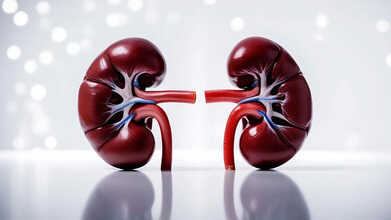- Health Conditions A-Z
- Health & Wellness
- Nutrition
- Fitness
- Health News
- Ayurveda
- Videos
- Medicine A-Z
- Parenting
- Web Stories
French Scientist Who Invented Abortion Pills Dies At 98

Source: AFP
For the longest women's health have been ignored in medicines. While there is progress, but it still needs to go in a long way. However, whatever has been succeeded has not always been easy. But, imagine a life without options, with a Plan B? Thanks to Étienne-Émile Baulieu, the French scientist who passed away at the age of 98 in his home in Paris for developing the abortion pill.
Renowned for his groundbreaking work on steroid hormones, Baulieu dedicated his career to advancing scientific knowledge and championing individual freedom. His institute remembered him as someone whose work was shaped by a deep commitment to progress, human dignity, and better living.
Also Read: Inside Minneapolis' Silent Room: A Place That Makes You Question If Silence Heals or Haunts
All About the Abortion Pill Inventor?
Born Étienne Blum in Strasbourg on December 12, 1926, Baulieu changed his name when he joined the French Resistance at the age of 15 during the Nazi occupation. This early experience shaped his lifelong values of liberty and courage. After completing medical and science doctorates, he began pioneering research in endocrinology and hormonal medicine.
Abortion Pill: An Invention That Changed the Lives Of Millions
In 1982, Baulieu developed RU-486—commonly known as mifepristone or the abortion pill. The drug offered a non-invasive, medically safe alternative to surgical abortion. It was a turning point in reproductive healthcare, providing millions of women worldwide with a private and less traumatic method of ending a pregnancy.
Despite its significance, the pill attracted controversy. Baulieu faced severe backlash, including threats from anti-abortion groups. Even today, access to the medication is restricted or banned in certain countries. Yet, it remains one of the most widely used abortion methods, especially in places where surgical access is limited.
Also Read: Cancer Survivors Share The Small Wins That Helped Them Heal
Abortion Pill: The Impact, The Challenges
Since its development, mifepristone has been approved in over 100 countries. The World Health Organization included it on its list of essential medicines in 2010. Still, its availability remains a battleground, particularly in the United States, where recent legal rulings have challenged access to abortion pills.
Baulieu continued to defend his work until the end, noting in a 2023 interview that restricting access to the drug undermines decades of progress toward gender equality and freedom.
His research extended into the fields of aging and mental health. His work on the hormone DHEA led to significant findings about neurosteroids, and he pursued treatments for Alzheimer’s and depression. In 2008, he founded the Institut Baulieu to focus on preventing and understanding neurodegenerative diseases.
He received France’s highest honors, including the Grand Cross of the Legion of Honour and leadership roles in the Academy of Sciences. Leaders including French President Emmanuel Macron praised him as a visionary who changed the world. Macron wrote, “Few French people have changed the world to such an extent,” calling Baulieu a “beacon of courage.”
Baulieu is survived by his wife, three children, eight grandchildren, and nine great-grandchildren. His work—especially the invention of the abortion pill—remains a powerful symbol of science serving humanity.
Unique Symptoms of the ‘Unpleasant’ Winter Bug Spreading in UK, NHS Issues Alert

Credits: Canva
Health officials in the UK have issued a 48-hour warning after a rise in cases of an “unpleasant” winter bug. The UK Health Security Agency (UKHSA) has urged people to stay home for two days after symptoms subside to help stop the spread of norovirus, commonly known as the “winter vomiting bug.” The virus, which causes vomiting and diarrhoea, spreads easily, particularly in colder months.
Recent data shows that cases have started to climb across England in recent weeks. The NHS has supported the UKHSA’s advice, reminding people to remain at home for at least 48 hours after symptoms clear to avoid infecting others.
What Is The Winter Bug Spreading In UK?
Norovirus is a highly contagious group of viruses that cause sudden vomiting and diarrhea. It spreads easily through contaminated food, water, and surfaces, and is known to peak during the colder months. In fact, it’s the leading cause of foodborne illness in the United States.
The virus was first identified in 1968 after an outbreak in an elementary school in Norwalk, Ohio, which gave it its original name, the Norwalk virus.
Norovirus vs. the Stomach Flu
Although often called the “stomach flu,” norovirus is not related to influenza. The flu virus affects the respiratory system, while norovirus targets the digestive tract, causing gastroenteritis.
Types of Norovirus
Norovirus belongs to the Caliciviridae family and includes 10 groups with around 48 known types. Among these, the GII.4 strain is the one most often linked to widespread outbreaks.
Unique Symptoms of Norovirus
Here are some less-covered but important unique symptoms of Norovirus infection to watch for:
- A sudden, intense onset of vomiting and watery diarrhoea, often without warning.
- Rapid loss of appetite and stomach cramps that may begin only 12 to 48 hours after exposure.
- Feeling unwell with low-grade fever, head or body aches, chills or muscle pain that accompany the GI symptoms.
- Signs of dehydration early on, such as dark urine, dry mouth, faintness on standing, or crying with few or no tears especially in children, older adults or immune-weakened people.
Unusual how quickly it hits and how short-lived it often is: many people recover in 1-3 days, yet they can still spread the virus for days after symptoms stop
To help stop the virus from spreading, the NHS has urged people with symptoms to take extra care, as per NHS. Those affected should:
- Avoid going to work, school, or nursery until at least 48 hours after their last episode of vomiting or diarrhoea.
- Refrain from visiting hospitals, care homes, or other vulnerable settings during the same period.
- These precautions are crucial because norovirus remains highly contagious even after symptoms appear to have cleared.
How to Stop Norovirus from Spreading
Contaminated food and water can also transmit the virus. Along with staying home while you’re unwell, the NHS recommends taking the following precautions to reduce the risk of passing it on:
Wash your hands thoroughly with soap and warm water after using the toilet or changing nappies, alcohol-based hand gels do not kill norovirus.
- Clean your hands before handling food, whether you’re cooking, serving, or eating.
- Launder soiled clothes and bedding separately at 60°C if they’ve come into contact with vomit or stool.
- Disinfect frequently touched surfaces, including toilet seats, taps, flush handles, and door handles.
- Limit physical contact with others until you’ve been symptom-free for at least two days.
Hyderabad Faces Surge in Mysterious Kidney Disease Among Healthy Youth, Study Finds

Credits: Canva
A chronic kidney disorder of unknown origin, referred to as Chronic Kidney Disease of unknown etiology (CKDu), is leading to kidney failures in Hyderabad and nearby districts of Telangana, alarmingly affecting younger adults who are economically active and have no prior history of diabetes or high blood pressure.
A team of senior nephrologists from Osmania General Hospital (OGH) and Apollo Hospitals studied 75 patients and published their findings in the Indian Journal of Nephrology (August 2024). The study revealed that while the disease resembles the mysterious kidney failures reported in Andhra Pradesh and other states, it shows a distinct, city-specific pattern of risk in Hyderabad.
Mysterious Kidney Disease In Hyderadabad
A mysterious kidney condition, called chronic kidney disease of unknown etiology (CKDu), is increasingly being reported among younger, non-diabetic residents in Hyderabad and nearby districts of Telangana, a study led by nephrologists reveals. Unlike traditional CKDu cases, which are often associated with agricultural work and heat exposure, this urban group largely comprises small business owners and service-sector workers with no farming history.
“Our research confirms the presence of the CKDu phenotype in Telangana, beyond the established hotspot regions, showing that an agricultural background is not required for the disease to develop,” said Dr. Manisha Sahay, Head of Nephrology at OGH and lead author of the study.
While CKDu in other regions is typically linked to strenuous farm labor and heat exposure, clinical data from OGH indicate that different, non-occupational factors may be driving the disease in younger, economically active individuals with no farming history. The condition progresses silently, often only producing symptoms once the kidneys are severely damaged, making urgent treatment at hospitals like Osmania General Hospital necessary.
What Is Chronic Kidney Disease Of Unknown Etiology?
Chronic kidney disease of unknown etiology (CKDu) is a type of chronic kidney disease with no identifiable cause, commonly observed in agricultural communities in certain regions. It is believed to arise from multiple factors, including environmental exposures such as pesticides, heavy metals, heat stress, dehydration, and contaminated water. According to the International Society of Nephrology, CKDu is diagnosed when known risk factors for chronic kidney disease, such as diabetes and hypertension, are absent.
What Are The Possible Causes Of Chronic Kidney Disease Of Unknown Etiology?
While the exact cause of CKDu is not confirmed, researchers suggest several possible contributors. The disease is likely multifactorial, arising from a combination of factors rather than a single cause. Environmental toxins, including heavy metals, pesticides, and mycotoxins, are under investigation. Heat stress and repeated dehydration from strenuous work in hot climates may also damage kidney tubules. Other potential factors being studied include contaminated water supplies and viral infections.
Kidney biopsies of patients at OGH revealed widespread scarring and inflammation in the kidney’s filtering units, indicating that the disease starts silently in this critical compartment.
“The damage observed in these biopsies highlights the severe consequences of late diagnosis, a pattern seen consistently across all CKDu-affected regions. Since the disease remains largely asymptomatic in its early stages, patients often reach urban hospitals only when they urgently need dialysis or renal replacement therapy,” said Dr. Manisha Sahay, Head of Nephrology at OGH.
CKDu in Hyderabad Linked To Urban Lifestyles and Unregulated Herbal Remedies
“While globally, 60 to 80 percent of CKDu cases occur among agricultural workers, only 21.3 percent of the Hyderabad patients were involved in rice farming,” noted Dr. Manisha Sahay in the study. “This shows that the CKDu phenotype affects a broad range of individuals from non-agricultural backgrounds, including small business owners, service-sector employees, and urban residents.”
Adding to the concern, 40 percent of patients in the OGH study reported using unregulated alternative or herbal medicines. Researchers emphasize that this widespread local practice may represent a significant risk factor, highlighting the need for urgent public health investigations targeting local dispensaries and providers of traditional remedies.
Hand, Foot And Mouth Disease Strikes U.S. Day-Cares: What Parents Must Know

Credits: Canva
Health authorities have reported an active outbreak of hand, foot and mouth disease in Tennessee, impacting close to 200 children and staff members across multiple schools.
In its latest update on Monday, October 20, the Shelby County Health Department confirmed that 178 cases have been identified among students and staff in 31 schools and three daycare centers.
What Is Hand, Foot And Mouth Disease?
Health officials in Tennessee have issued a warning about a “highly contagious” illness spreading through several schools and childcare facilities.
The Shelby County Health Department confirmed in a recent statement that an outbreak of hand, foot and mouth disease (HFMD) has been detected across 31 schools and three childcare centers in the state.
According to the Centers for Disease Control and Prevention (CDC), hand, foot and mouth disease is a contagious viral infection that typically leads to fever, mouth ulcers, and a skin rash. Although it most often affects children under the age of five, people of any age can contract it. Symptoms usually persist for about a week to ten days.
The CDC explains that the virus spreads easily through droplets released when an infected person coughs, sneezes, or talks, as well as through contact with contaminated objects, surfaces, or fluid from blisters.
Symptoms Of Hand, Foot And Mouth Disease
Hand, foot and mouth disease (HFMD) usually develops in two stages. In the beginning, children often experience mild, flu-like symptoms such as a low fever, sore throat, runny nose, stomach discomfort, and loss of appetite. These early signs typically subside after a few days, followed by the appearance of an itchy rash on the palms, soles, elbows, knees, or buttocks, along with painful mouth sores that may form on or around the tongue, as per Cleveland Clinic.
These sores usually start as small pink spots before turning into blisters, and some children may also develop swollen lymph nodes in the neck. Most cases clear up within a week to ten days, though recovery can take longer in children under two years old.
What Causes Hand, Foot And Mouth Disease?
The illness is caused by viruses from the coxsackievirus and enterovirus families, which are commonly found in the mouth and digestive tract. HFMD is highly contagious, especially in the first few days of infection and often before the rash appears. While the blisters usually dry up within ten days, the virus can linger in stool for several weeks, meaning children may still spread it after symptoms have disappeared. The infection spreads through droplets released when an infected person coughs or sneezes, through direct contact with saliva, stool, or fluid from blisters, and by sharing utensils, cups, or towels. It can also spread by touching contaminated toys, surfaces, or doorknobs and then touching the mouth, nose, or eyes.
The Shelby County Health Department stated that it has been working closely with schools and childcare centers to track the outbreak and reduce the spread of the infection.
Dr. Bruce Randolph, Director and Health Officer of the department, noted that while most cases of hand, foot and mouth disease are mild, the virus can spread rapidly in group settings such as classrooms and daycare facilities. He advised parents to keep affected children at home until their fever has subsided, they are feeling better, and their mouth sores or blisters have started to heal.
© 2024 Bennett, Coleman & Company Limited

